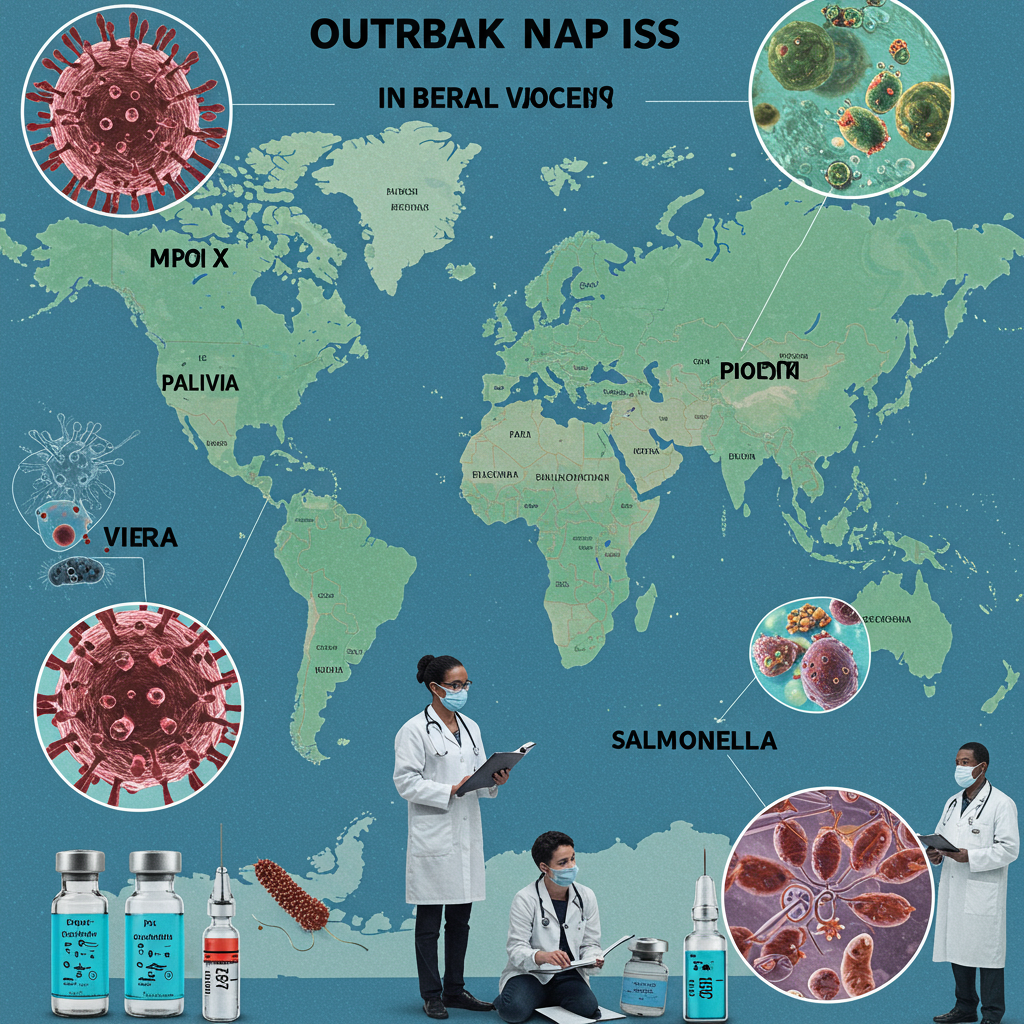The global health landscape is currently navigating a complex web of emerging and intensifying disease outbreaks, demanding heightened vigilance and coordinated public health responses. From localized mpox transmission in Europe to a devastating cholera crisis in Africa and widespread measles resurgences, these global health alerts underscore the critical need for robust surveillance, rapid intervention, and widespread vaccination efforts. This essential overview unpacks the most pressing infectious disease developments, offering crucial insights into current risks and recommended actions.
Mpox: Europe Confronts Local Clade 1b Transmission
A concerning shift in mpox epidemiology is unfolding across Europe, where the European Centre for Disease Prevention and Control (ECDC) has issued an alert following the detection of locally acquired clade 1b mpox cases. This development signals community transmission, moving beyond previously travel-linked infections.
Understanding the Clade 1b Threat
Five recent cases, reported in Spain, the Netherlands, Italy, and Portugal, showed symptom onset between September 16 and October 7. While these cases presented with mild disease courses, two of the three patients with available information were men who have sex with men (MSM). The ECDC assesses the immediate risk to the general population as low. However, the overall risk of infection is moderate for MSM, with a potentially higher risk of severe outcomes for individuals living with untreated HIV.
Historically, clade 1b is considered more severe than clade 2b, the strain responsible for most global outbreaks since 2022. Despite this, uncertainties persist due to the relatively small number of documented clade 1b cases. Out of 29 earlier clade 1b cases, seven required hospitalization, highlighting the potential for serious illness. Beyond Europe, the United States has also reported three unrelated, non-travel-related clade 1 mpox cases among MSM in California.
A Multipronged Public Health Response
In response to this evolving situation, the ECDC advocates for a comprehensive public health strategy. This includes:
Targeted Vaccination: Prioritizing at-risk populations, including both pre-exposure and post-exposure vaccination.
Accessible Testing: Ensuring readily available and accurate diagnostic capabilities.
Clade Identification: Swiftly determining the specific mpox clade to inform treatment and containment strategies.
Prompt Diagnosis & Isolation: Quickly identifying infected individuals and implementing isolation measures to prevent further spread.
Robust Contact Tracing: Diligently tracking and notifying contacts of confirmed cases.
Public Education: Disseminating clear and accurate information to empower communities and at-risk groups.
Cholera Crisis: A Growing Catastrophe in the Democratic Republic of Congo
The Democratic Republic of Congo (DRC) is grappling with an escalating cholera outbreak, prompting urgent warnings from Medecins sans Frontieres (MSF). Over the past nine months, the DRC Ministry of Health has reported a staggering 58,000 cholera cases and 1,700 deaths, impacting 20 of the country’s 26 provinces.
Regional and Local Drivers of the Epidemic
This severe outbreak is part of a broader regional crisis, with 23 countries across Africa collectively battling over 172,000 cases since January 1. The DRC, Sudan, and South Sudan bear the brunt of this humanitarian disaster, accounting for a significant 75% of the region’s total cases and fatalities.
MSF officials attribute the intensification of the DRC outbreak to a convergence of factors. Widespread floods, ongoing conflicts, and mass population displacements create fertile ground for the disease’s spread. Critically, inadequate sanitation infrastructure and insufficient access to clean water exacerbate the crisis. The response efforts are further hampered by insufficient government funding, a limited presence of humanitarian organizations, and acute shortages of vital medical supplies and vaccines. With the rainy season approaching, MSF warns that the situation is likely to worsen, expressing fears of further outbreaks without immediate and decisive interventions. Cholera, caused by the Vibrio cholerae bacterium, spreads through contaminated water and food. It leads to severe dehydration and can be rapidly fatal if left untreated, though it is readily treatable with rehydration solutions and antibiotics.
Measles Resurgence: Alarms Sound Across the US and Globally
Measles, a highly contagious viral disease, is making a concerning comeback in various regions, particularly within the United States. The nation has recently experienced its second-largest measles outbreak this year, with cases surpassing 124 in a tightly-knit community spanning northwestern Arizona and southwestern Utah. Specifically, Mohave County in Arizona reported 80 cases, while Washington County in Utah confirmed 44. Recent detections in larger nearby towns like Hurricane and St. George, Utah, indicate further spread. This outbreak follows a larger one in West Texas, which recorded 762 confirmed cases before concluding in August.
Further intensifying concerns, Maryland confirmed a new measles infection in a Montgomery County resident with a history of international travel, prompting public exposure alerts at Washington’s Dulles International Airport and other local venues. Ohio also reported its first measles case of 2024, involving a child in Montgomery County, leading to potential exposures at Dayton Children’s Hospital. These domestic cases align with the Centers for Disease Control and Prevention’s (CDC) recent call for healthcare providers to remain vigilant, particularly for individuals with international travel histories, given the rising global numbers of mostly imported cases.
Polio Vaccination Urgency: A Global Health Imperative
On World Polio Day, the World Health Organization (WHO) issued a stark warning regarding alarmingly low polio vaccine uptake in Europe. Vaccination rates have plummeted to their lowest point since 2017, leaving over 450,000 babies unprotected. This significant gap in immunization coverage presents a critical health security risk, not only for Europe but also for global eradication efforts.
The urgency of this situation is underscored by new polio infections confirmed elsewhere. Afghanistan reported two new cases of wild poliovirus type 1 (WPV1) in early October, bringing its 2025 WPV1 total to nine. Papua New Guinea also confirmed two new cases of circulating vaccine-derived poliovirus type 2 (cVDPV2 with paralysis onsets in August, making it three cVDPV2 cases for the country this year. Adding to the gravity, reports indicate that a polio vaccine center in northern Gaza was hit by Israeli air strikes, injuring six individuals, including four children, amidst ongoing vaccination campaigns for 100,000 children in the area. These events highlight the fragility of polio eradication efforts in conflict zones and areas with low vaccination coverage.
Food Safety Alert: International Salmonella Outbreak Linked to Tomatoes
A prolonged, multi-country outbreak of Salmonella Strathcona has been confirmed by the ECDC, affecting 437 individuals across 17 European countries between January 1, 2023, and September 30, 2025. Italy, Germany, and Austria have been the most impacted European nations, with additional cases reported in the United States (24) and Canada (10).
Recent investigations in Austria in 2025 consistently identified small tomatoes originating from Sicily, Italy, as the source of infection. These findings align with earlier investigations from Italy (2024) and Austria (2023), firmly establishing a clear link between the produce and the widespread illness. This Salmonella outbreak serves as a vital reminder of the interconnectedness of global food supply chains and the importance of rigorous food safety protocols.
Additional Global Health Concerns
Beyond these major outbreaks, several other public health developments demand attention:
Chronic Wasting Disease (CWD) Expands in Montana
Montana Fish, Wildlife and Parks (FWP) confirmed the first detection of CWD in an elk within the Ruby Mountains, an area already known for high CWD prevalence in deer. This fatal neurological disease, caused by resilient prions, affects cervids like deer and elk. While not known to infect humans, officials recommend against consuming meat from sick animals and suggest precautions during field dressing. Hunters are advised on proper carcass disposal to curb the spread.
Emergence of Sexually Transmitted Fungal Infections
New York City has reported four US cases of an emerging sexually transmitted fungal infection, Trichophyton mentagrophytes type VII (TMVII), causing genital tinea or “ringworm.” These cases, among men who have sex with men (MSM), follow international reports linked to sex workers in Southeast Asia and MSM in France. Healthcare providers are urged to recognize TMVII’s sexual transmission route and its varied lesion locations, emphasizing the need for enhanced surveillance and education.
Persistent Healthcare Burden from COVID-19
A significant study revealed that healthcare utilization and costs substantially increased in the year following a COVID-19 infection, even among healthy adults who were not hospitalized. Increases were noted in new blood-related diagnoses (over 150%), neurologic, psychological, endocrine, nutritional, metabolic, and digestive conditions. This highlights a prolonged and substantial healthcare burden associated with COVID-19, impacting even previously healthy individuals.
Iodine Antiseptic Improves Surgical Outcomes for Fractures
A randomized clinical trial demonstrated that a skin antiseptic containing iodine significantly reduced surgical-site infections (SSIs) by over 25% in patients undergoing surgery for fractured limbs, compared to an antiseptic containing chlorhexidine gluconate. This finding is expected to inform new antiseptic practices for simple fracture repair, potentially preventing thousands of SSIs annually.
Global Surveillance and Preparedness Efforts
The US Centers for Disease Control and Prevention (CDC) has opened a new East Asia and Pacific regional office in Tokyo, aiming to strengthen global health security through enhanced collaboration. Meanwhile, an H1N1v swine flu case was identified in a pig farm worker in Spain, who has since recovered. In Laos, detections of H5N1 and H9N2 avian flu in poultry led to the temporary closure of a live-bird market, prompting warnings from the WHO and FAO about elevated human risk, especially during periods like Lunar New Year.
Improved Vaccine Uptake Following Policy Changes
A study in New York State found that banning nonmedical vaccine exemptions for school entry was associated with a statistically significant increase in vaccine uptake. This legislative change, implemented after measles outbreaks, effectively boosted vaccination compliance in both public and nonpublic schools without an increase in medical exemptions, demonstrating the impact of public health policy on immunization rates.
Frequently Asked Questions
What are the most urgent infectious disease outbreaks currently affecting global health?
Several critical infectious disease outbreaks are currently demanding global attention. These include localized clade 1b mpox transmission in European countries like Spain, the Netherlands, Italy, and Portugal, signaling community spread. The Democratic Republic of Congo is experiencing an intensifying cholera outbreak with over 58,000 cases in nine months, fueled by conflict and poor sanitation. Furthermore, measles outbreaks are resurfacing in the US Southwest, Maryland, and Ohio, coinciding with dangerously low polio vaccination rates in Europe and new polio cases in Afghanistan and Papua New Guinea. An international Salmonella outbreak linked to Sicilian tomatoes is also affecting multiple countries.
How are international health organizations responding to these outbreaks?
International organizations like the ECDC, WHO, and MSF are at the forefront of the response. The ECDC is urging targeted prevention measures for mpox, including vaccination, accessible testing, and robust contact tracing. The WHO is actively warning about critical polio vaccine uptake gaps and monitoring new cases globally, while MSF is providing crucial humanitarian aid and advocating for increased funding and resources to combat the intensifying cholera crisis in the DRC. These organizations emphasize surveillance, vaccination campaigns, public education, and rapid public health interventions to contain and mitigate these threats.
What immediate steps can individuals and communities take to reduce health risks from these threats?
Individuals and communities can take several vital steps to reduce risks. For vaccine-preventable diseases like measles and polio, ensuring up-to-date vaccinations is paramount. Practicing rigorous hygiene, including handwashing and safe food preparation, is crucial, especially concerning foodborne illnesses like Salmonella. For cholera, access to clean water and improved sanitation are critical; supporting organizations like MSF can help. Men who have sex with men should be aware of mpox symptoms and consider vaccination. Staying informed about local and international health alerts, following public health guidelines, and seeking medical attention promptly for symptoms are essential for personal and community protection.
Conclusion
The ongoing array of global health alerts, from mpox and cholera to measles and polio, underscores a persistent and dynamic threat landscape. These intertwined crises, often exacerbated by socio-economic factors, climate change, and conflicts, demand more than just reactive measures. They call for sustained international collaboration, equitable access to vaccines and healthcare, robust surveillance systems, and proactive public health strategies. By remaining vigilant, informed, and committed to collective action, we can better protect communities worldwide from these pressing infectious disease challenges.




